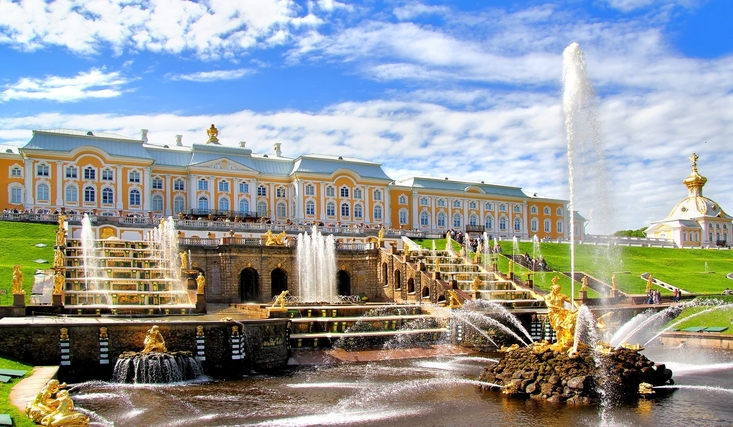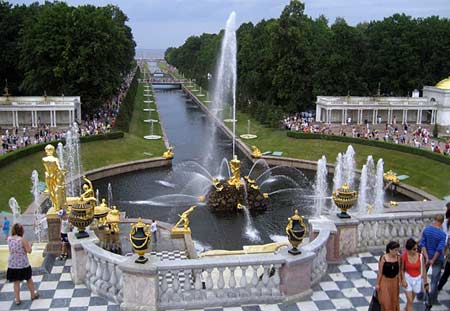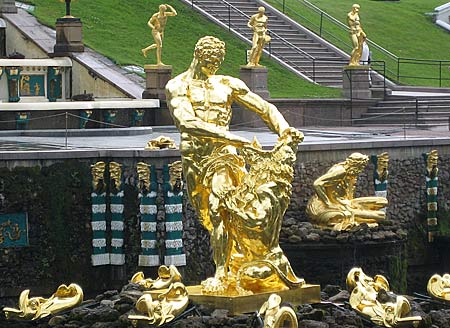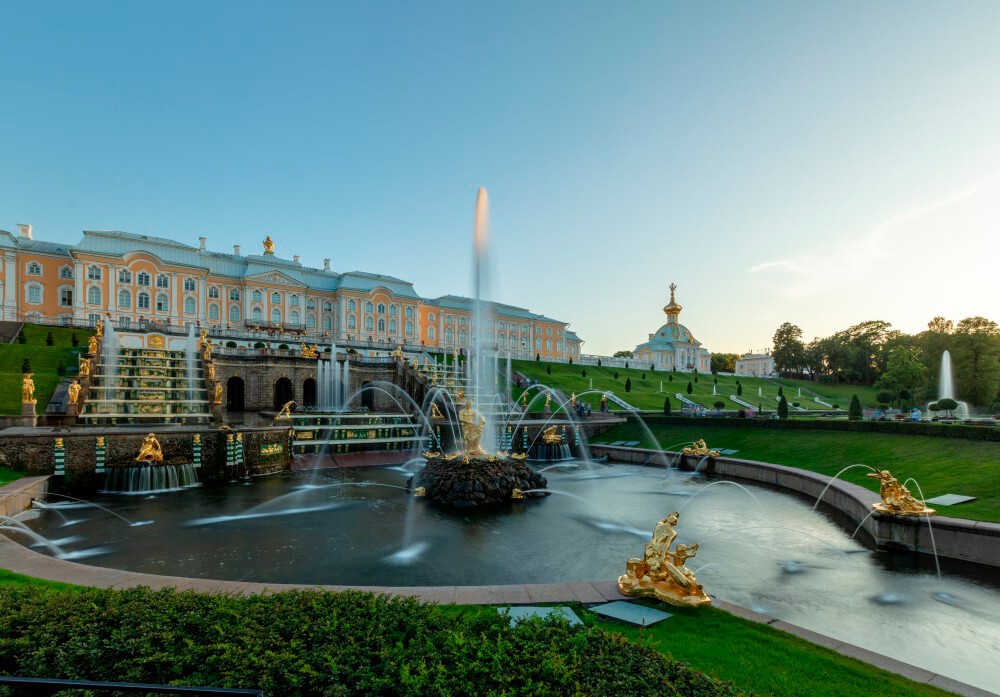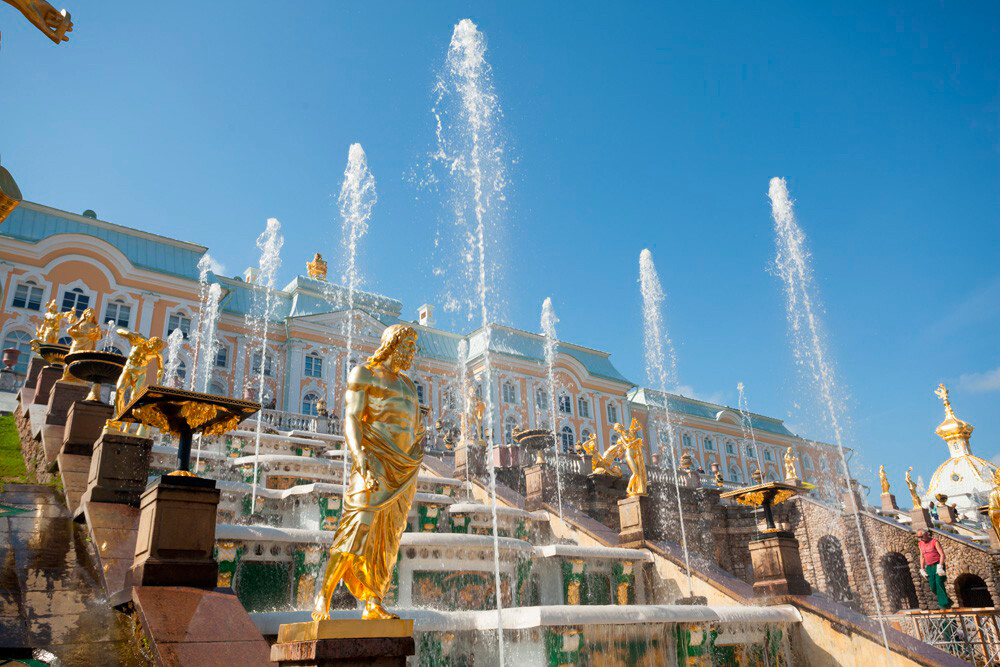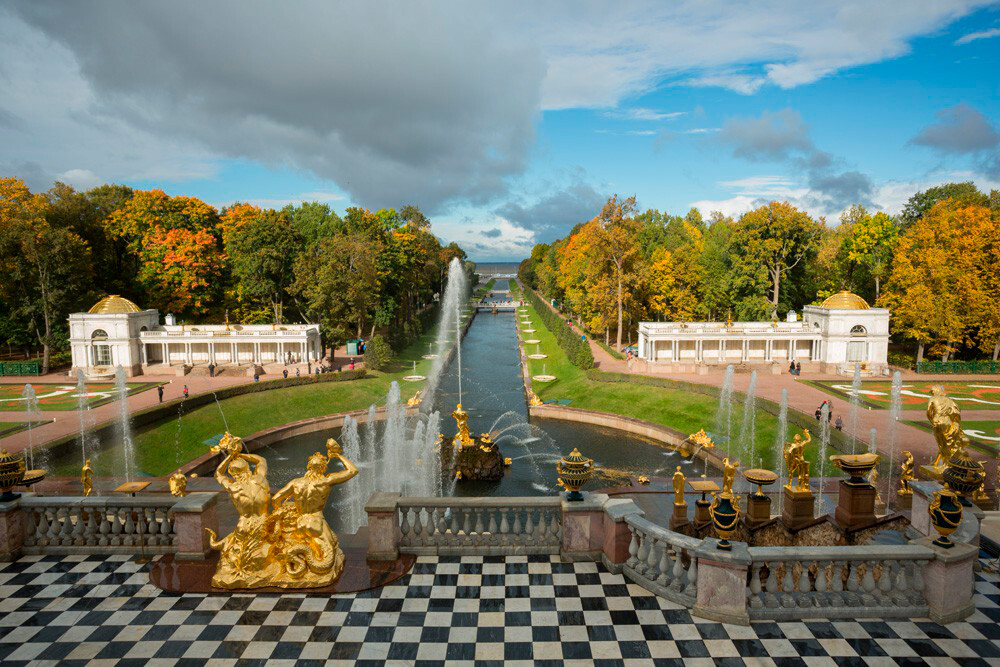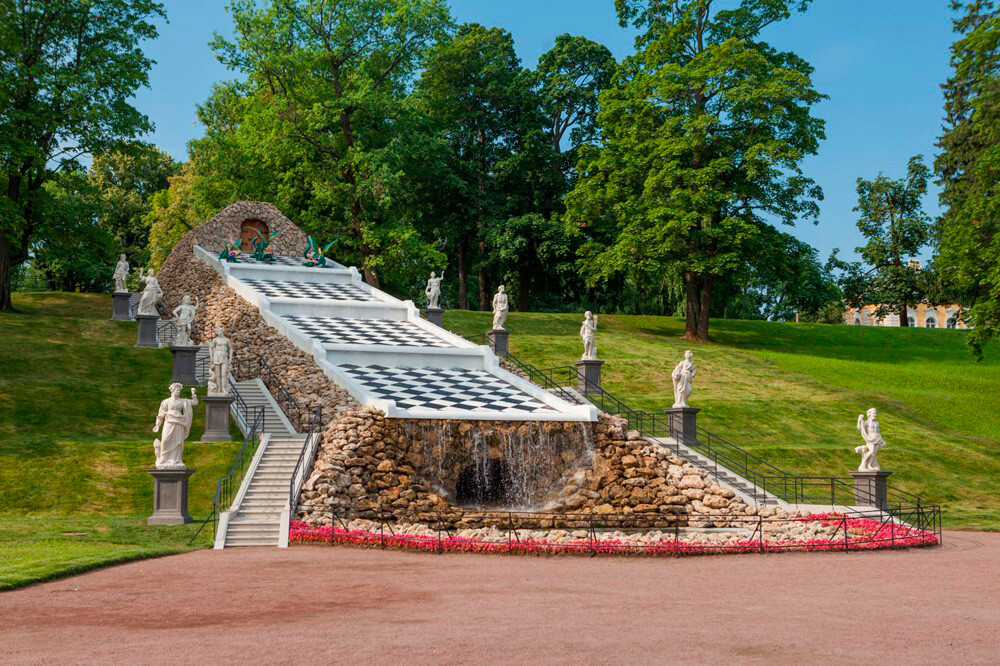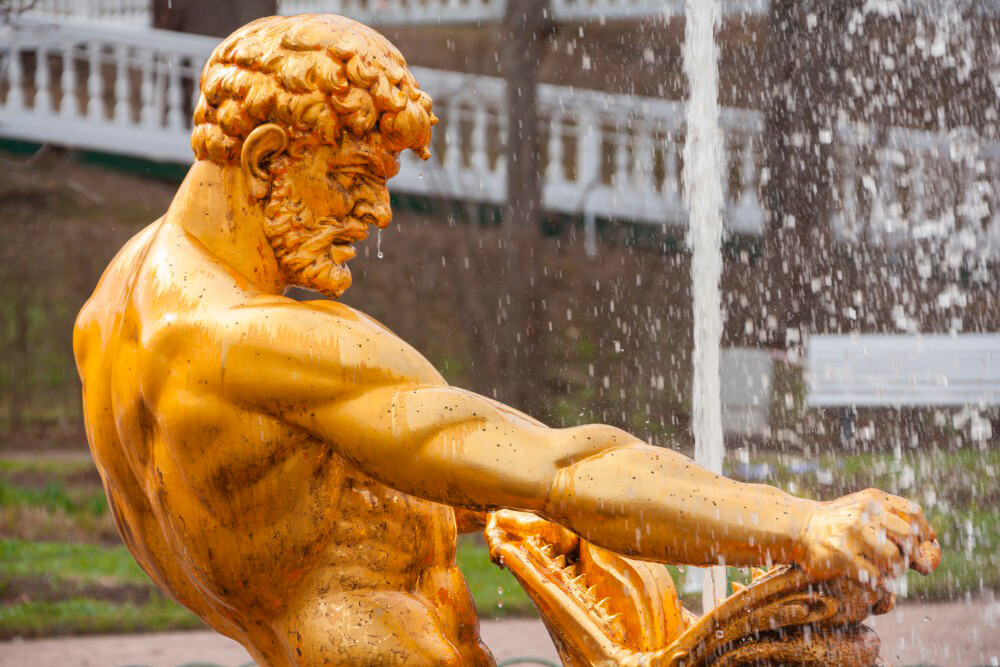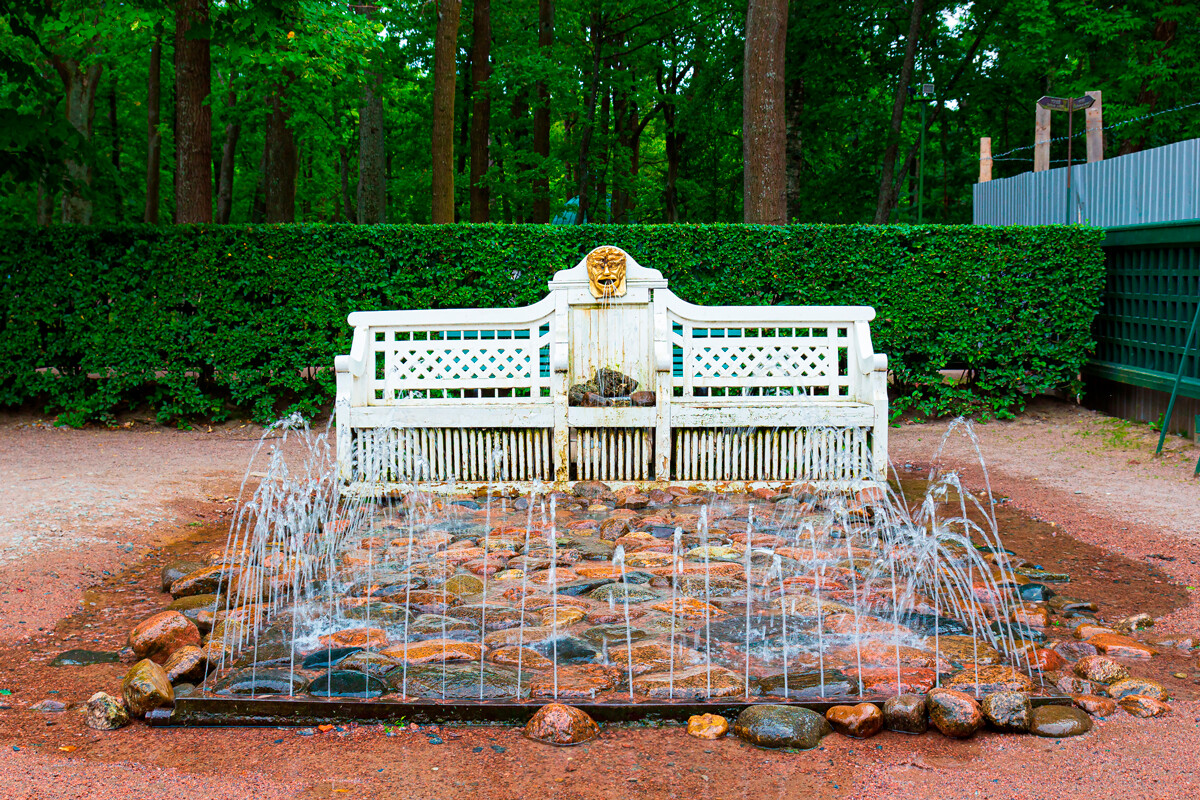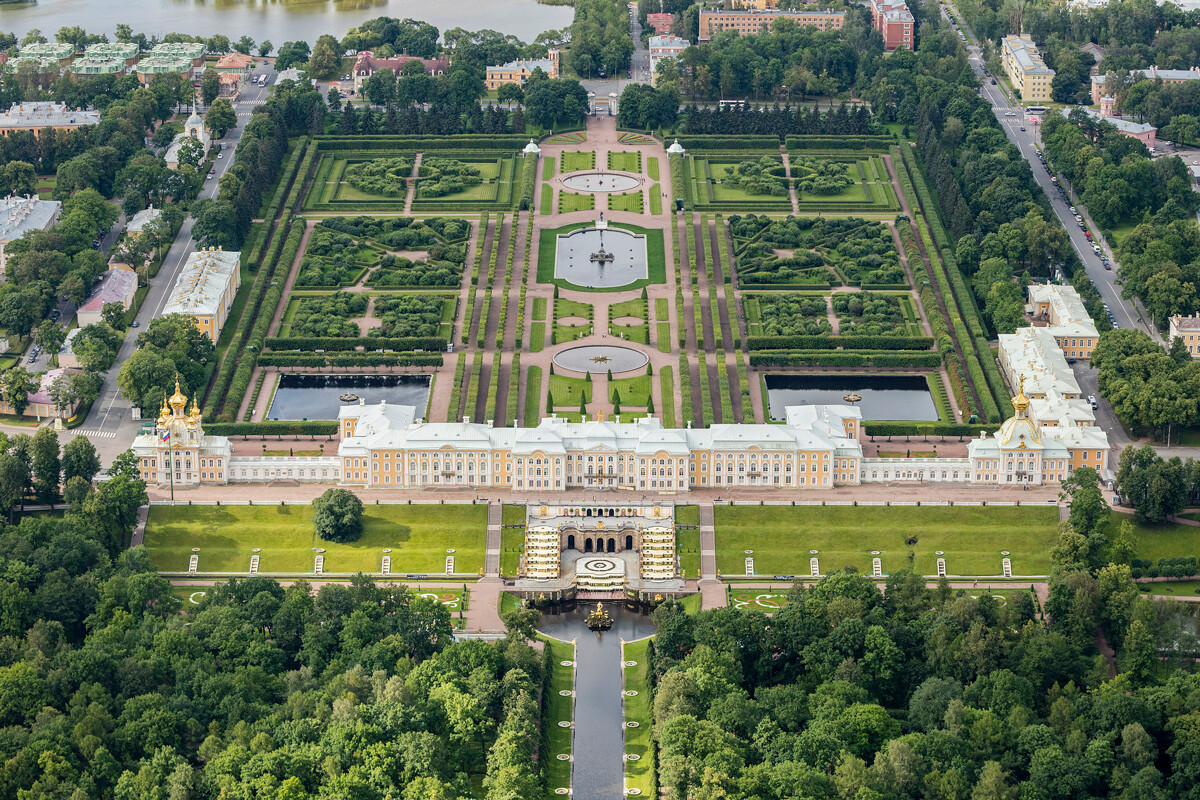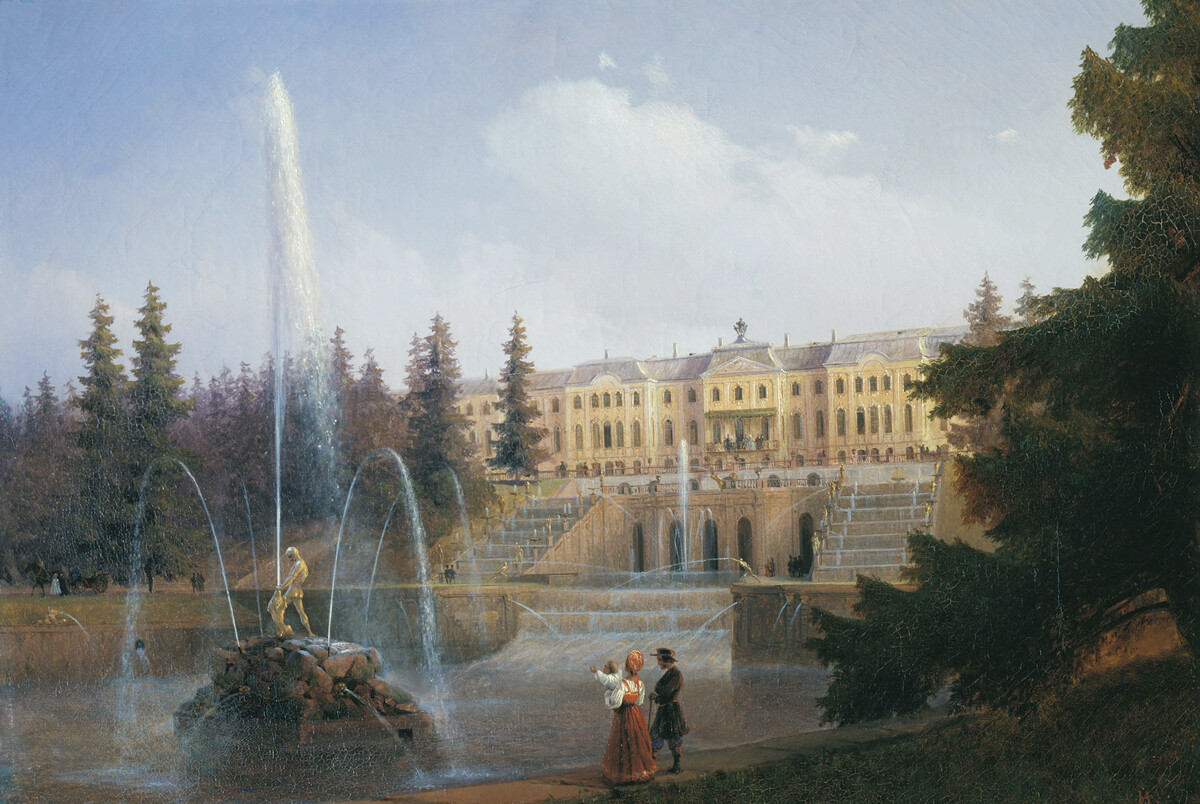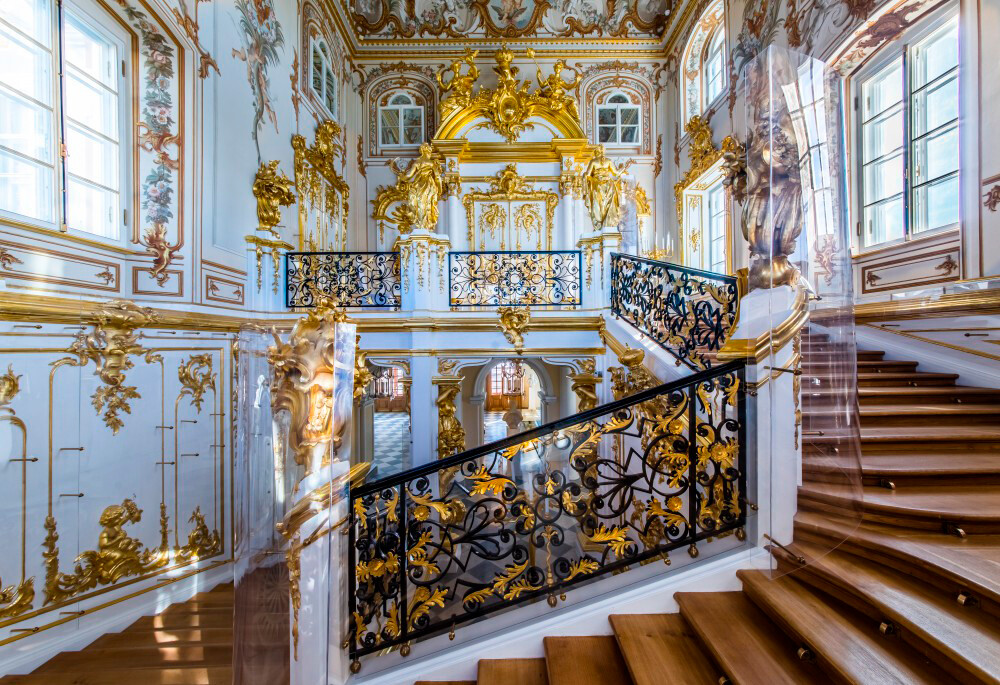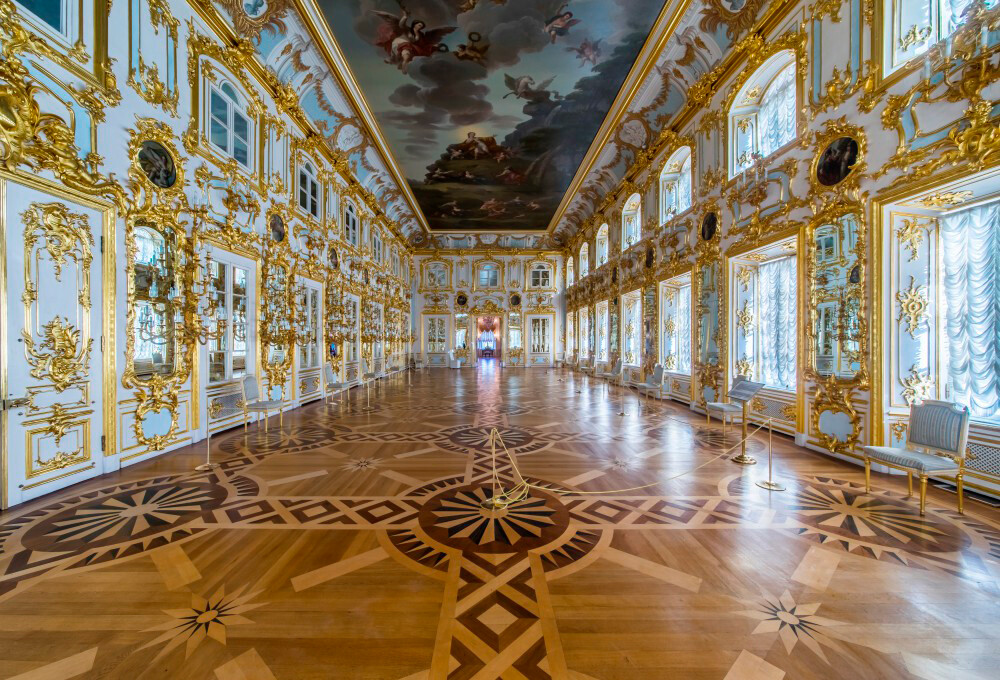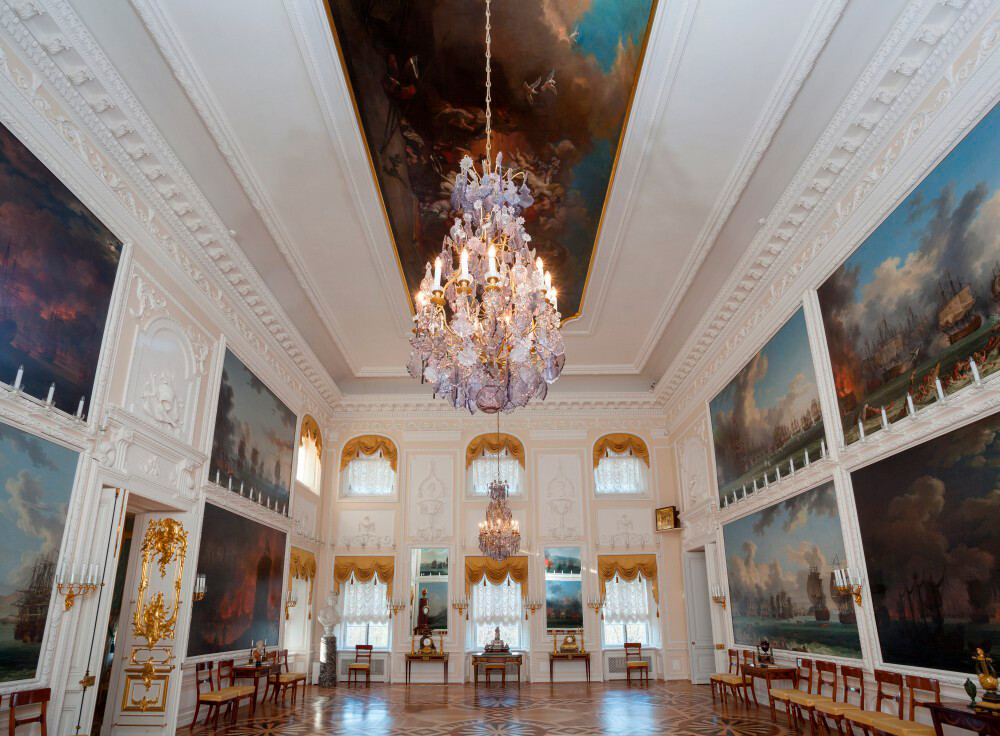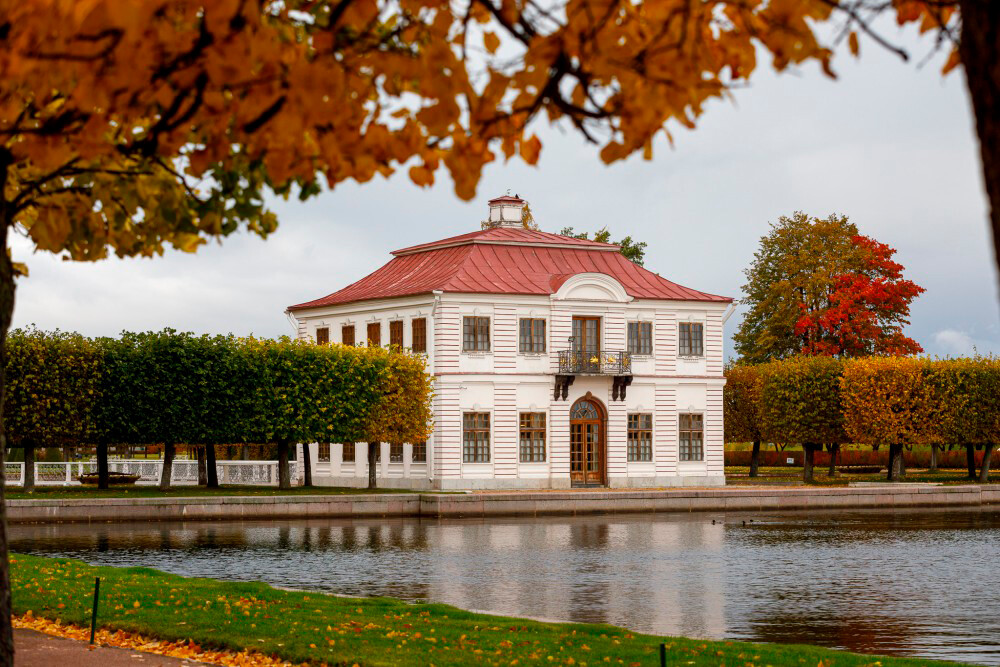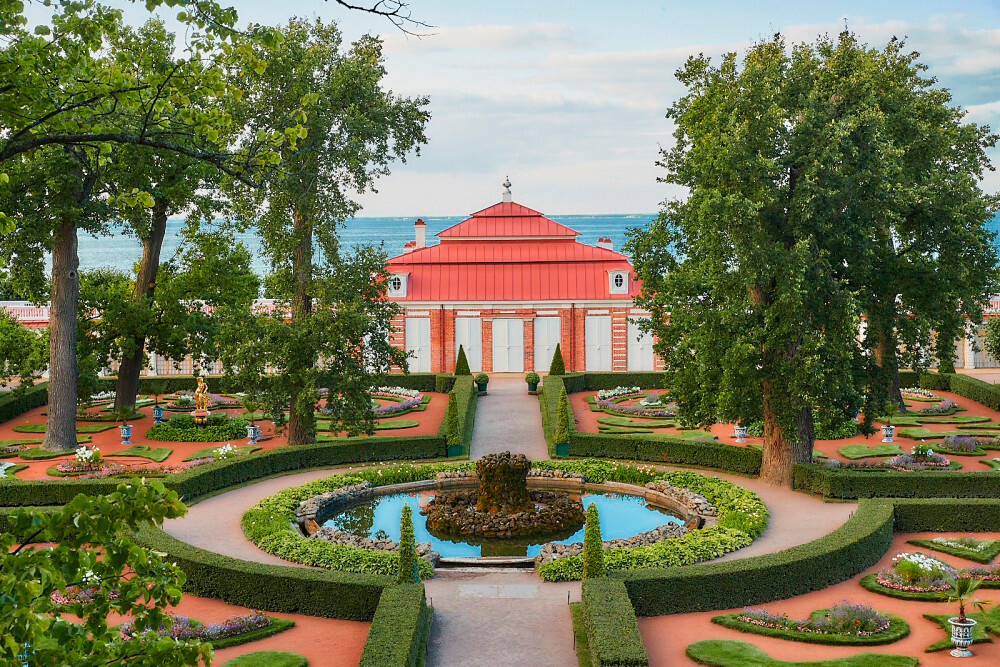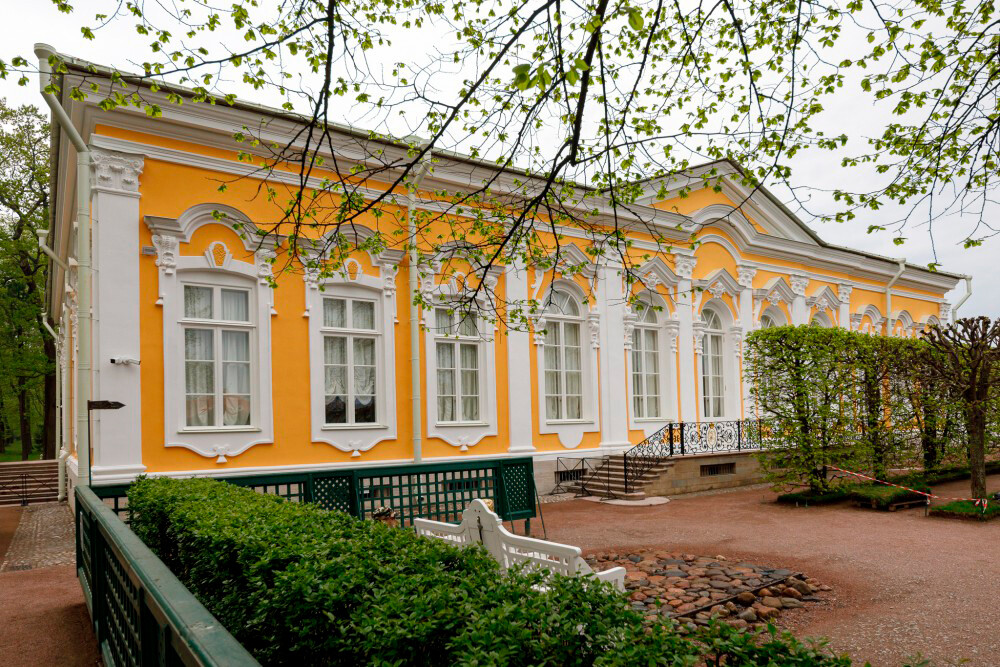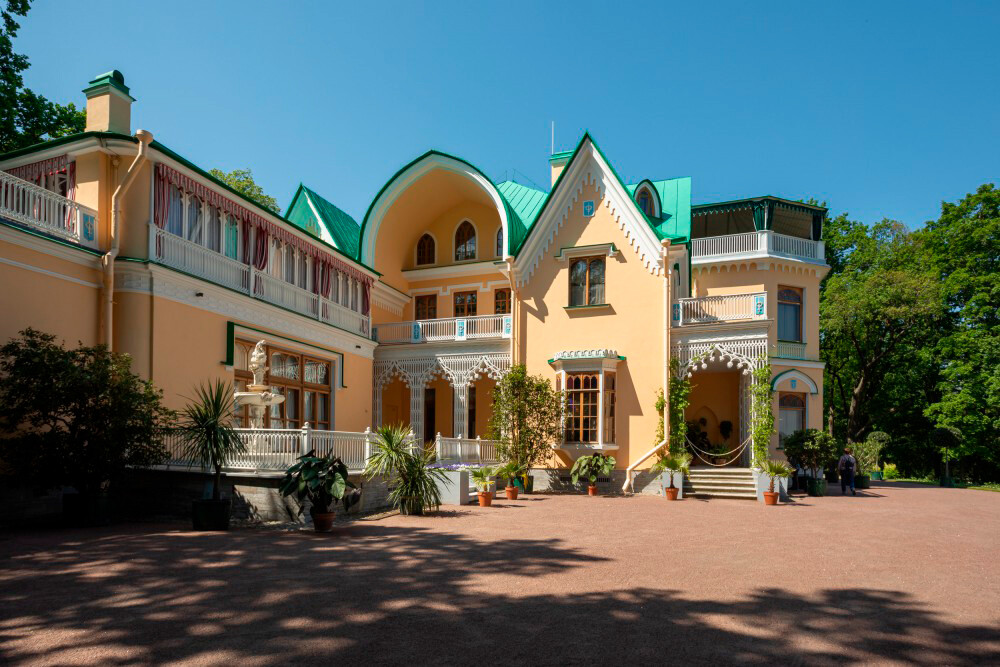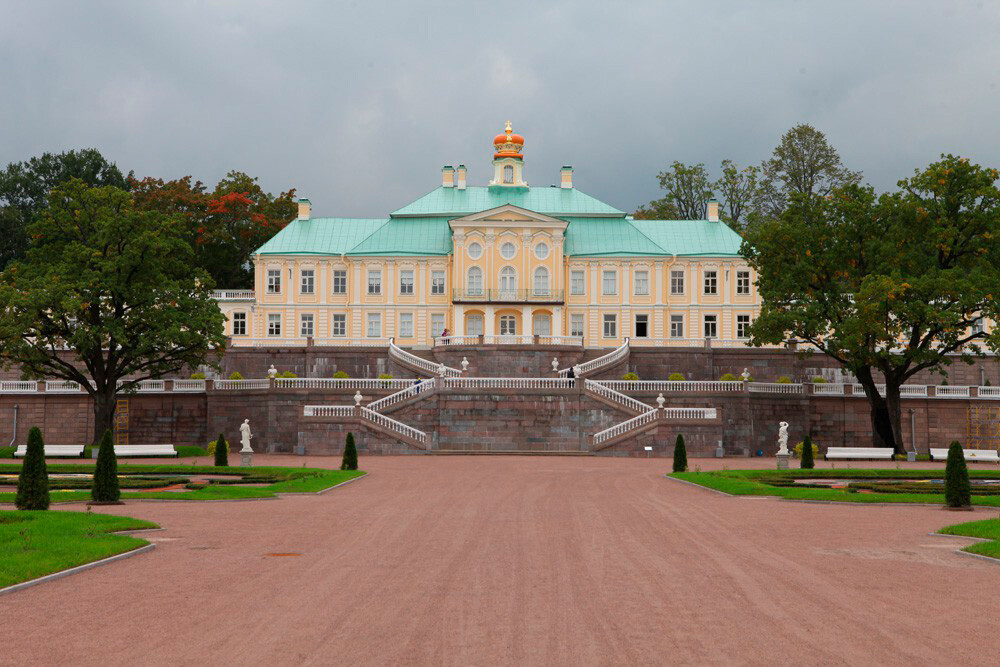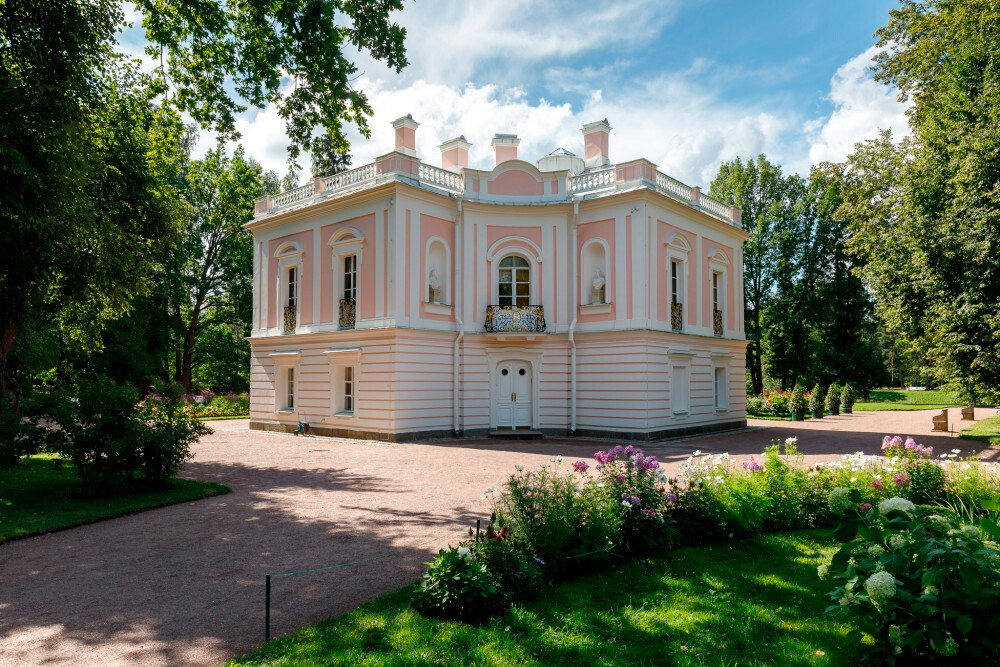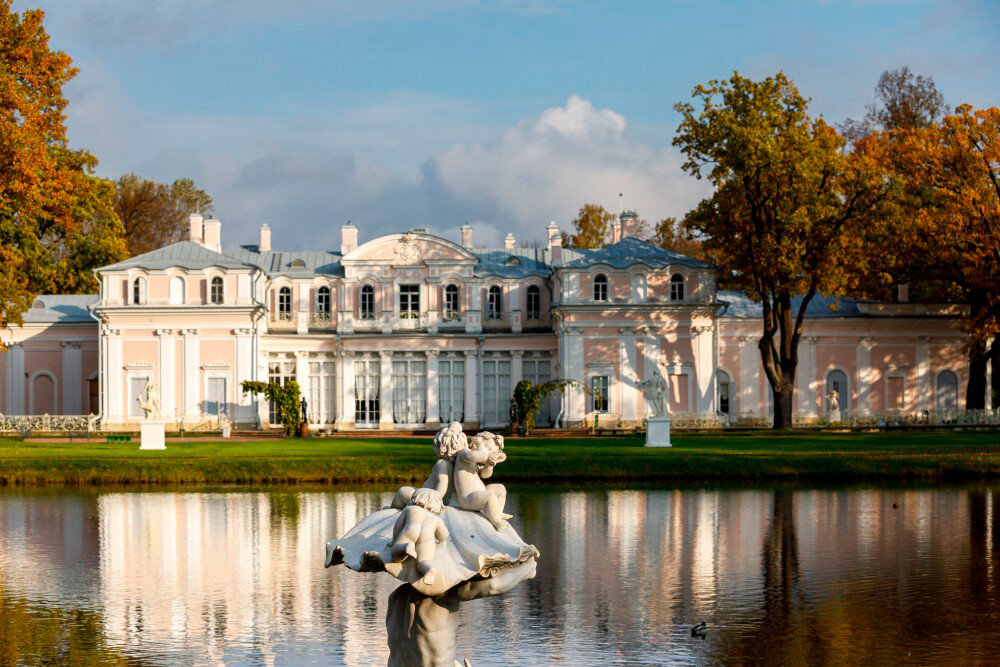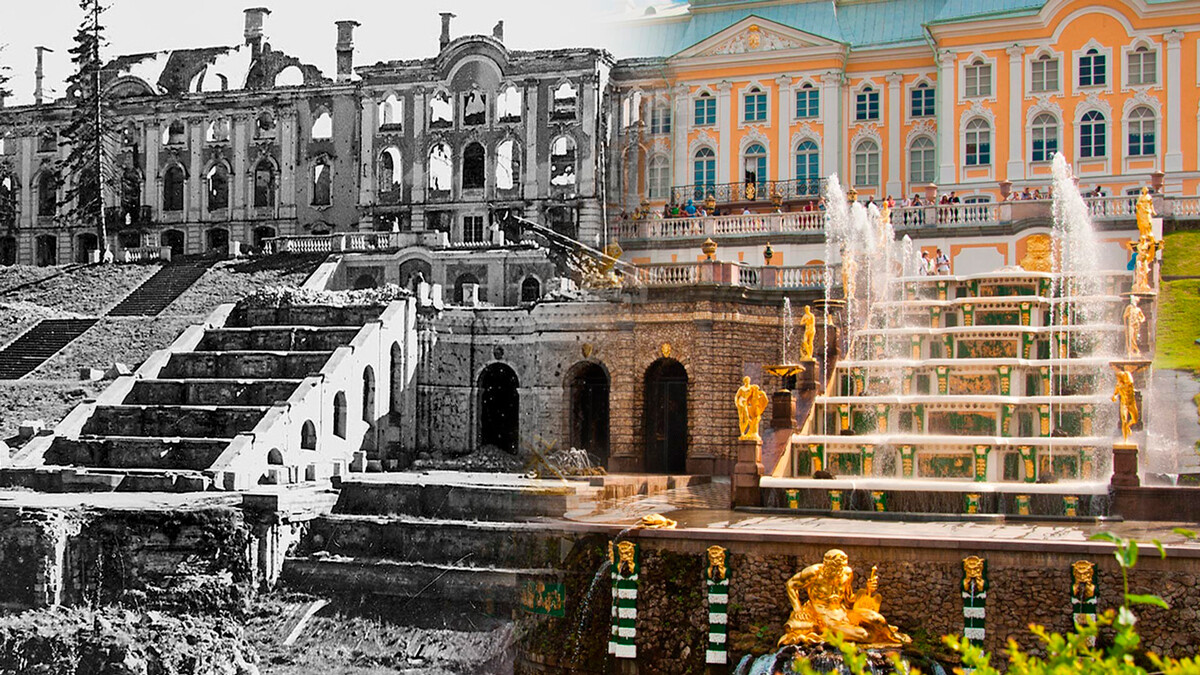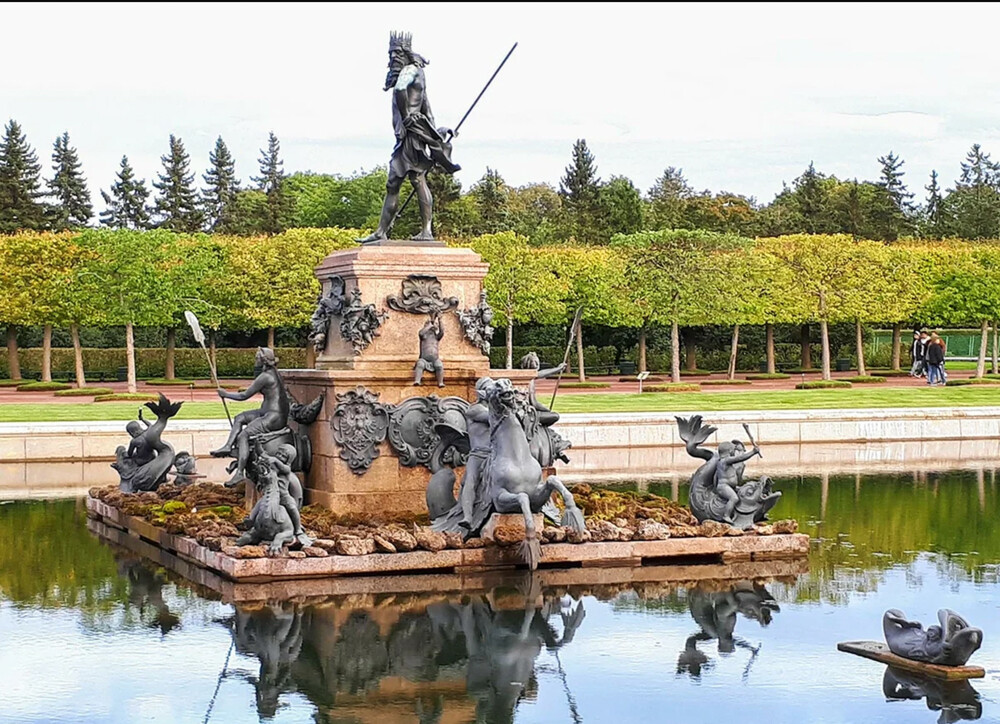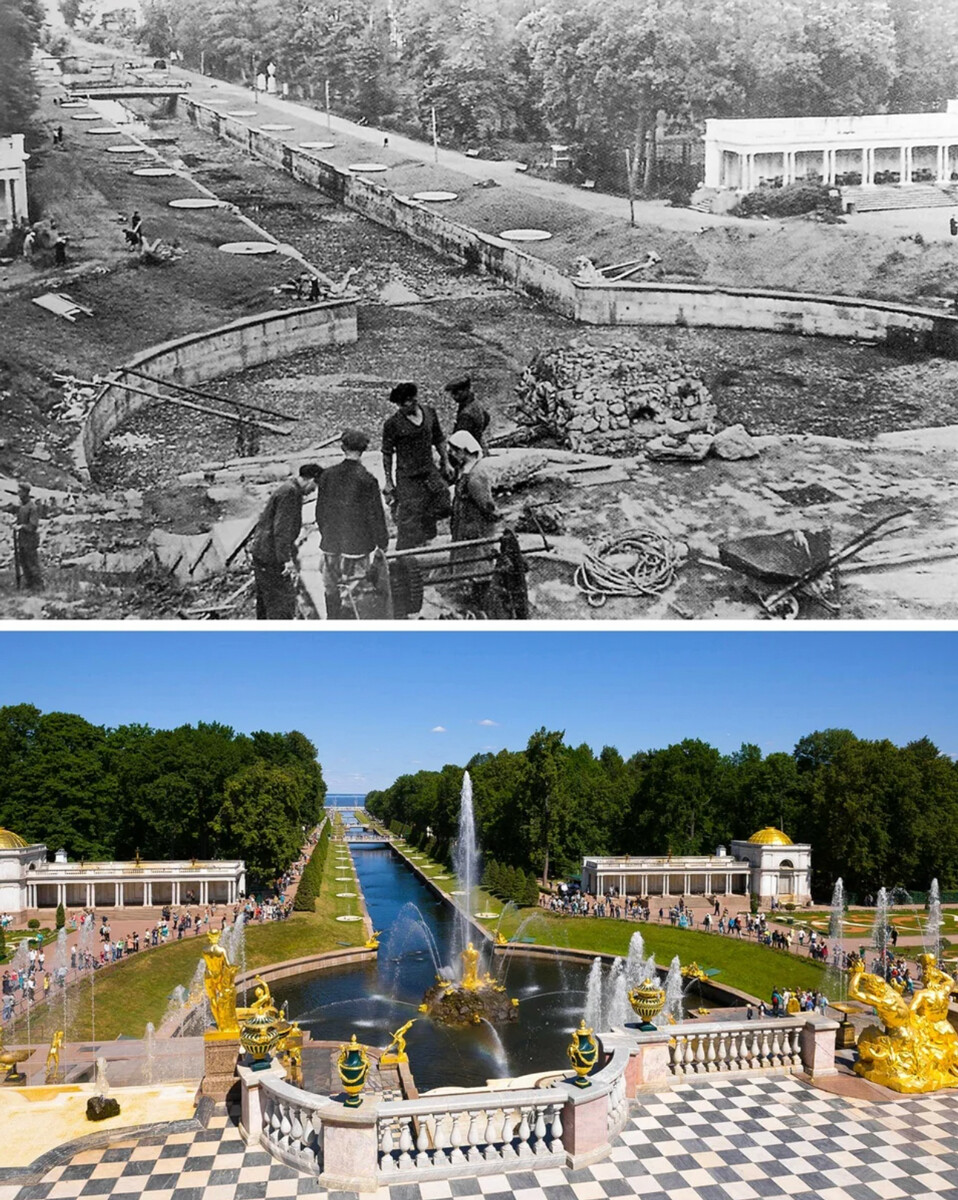Описание Петергофа
Факты проверены Текст проверен, ошибок быть не должно
Peterhof is a town at the shore of the Gulf of Finland, located about 30 kilometers west of St. Petersburg.
This small town is famous for its palaces and gardens of Peterhof, created by order of Peter the Great. The Peterhof ensemble consists of a set of palaces, gardens, museums and other buildings. It subsequently became the most lavish and popular of the Russian royal summer residences*.
The Grand Palace is located in the heart of Peterhof. It is built in the Baroque style. The author of the project is Francesco Bartolomeo Rastrelli.
The palace is a three-storey building of almost 300 metres in length. Until 1917, it was the residence of the Tsars. In 1918 it was transformed into a museum.
The palace is surrounded by majestic gardens and fountains. The Grand cascade is the most impressive fountain construction of the Peterhof ensemble. «Samson Rending the Lion’s Jaws» is the main sculptural group of the Grand cascade.
In 1990 the Peterhof ensemble was declared a World Heritage Site by UNESCO.
*Источник: энциклопедия Britannica
-
The State Hermitage Museum – Государственный Эрмитаж »
-
Saint Isaac’s Cathedral – Исаакиевский собор »
-
Официальный сайт музея-заповедника «Петергоф»
Перевод на русский язык
Петергоф – это город на берегу Финского залива, расположенный примерно в 30 км к западу от Санкт-Петербурга.
Этот небольшой городок знаменит своими дворцами и садами Петергофа, созданными по приказу Петра Великого. Петергофский ансамбль состоит из комплекса дворцов, садов, музеев и других строений. Впоследствии он стал самой роскошной и популярной из летних царских резиденций России*.
Большой дворец расположен в самом центре Петергофа. Он построен в стиле барокко. Автор проекта – Франческо Бартоломео Растрелли.
Дворец представляет собой трехэтажное здание длиной почти 300 метров. До 1917 года это была резиденция царей. В 1918 году он был преобразован в музей.
Дворец окружен величественными садами и фонтанами. Большой каскад – самое впечатляющее фонтанное сооружение петергофского ансамбля. «Самсон, разрывающий пасть льва» – главная скульптурная группа Большого каскада.
В 1990 году ансамбль Петергофа был внесен в Список всемирного наследия ЮНЕСКО.
*Источник: энциклопедия Britannica
-
Краткий текст про Санкт-Петербург »
-
Tourist attractions in Saint Petersburg – Достопримечательности Санкт-Петербурга »
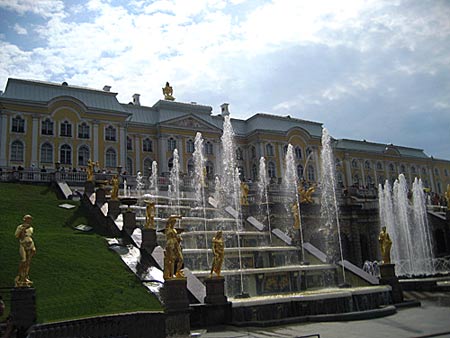
Peterhof is a small town, suburb of St. Petersburg. It is located on the shores of the Gulf of Finland, at a distance about 30 kilometers south-west of the center of St. Petersburg. The population of the town is about 78,500 people.
Peterhof got its name from the German word Peterhof — «Peter’s Court». From 1944 to 1997 the town was called «Petrodvorets».
Peterhof was founded in 1710 as the emperor’s country residence. It received the city status in 1762. There were villages Kuusoja and Pohjajoki on the place of Peterhof on the coast of the Gulf of Finland prior to the beginning of the XVIII century. The most famous town landmark is the «Peterhof» museum.
Sea Channel view of the in Peterhof from the Grand Palace is shown in the picture.
The Museum Peterhof includes: «Peterhof Grand Palace,» «Upper Garden», «Lower Park» and other objects.
The most interesting place for tourists (in summer) in Peterhof is «Lower Park». Lower Park has an area about 102 hectares. The park stretches from west to east along the coast of the Gulf of Finland by 2.5 kilometers. Its width from north to south is about 500 meters.
The main decorations of the park are its fountains. «Grand Cascade» fountain is situated in the central part of the park, in front of Grand Palace. «Sea Canal» is laid from the Grand Cascade to the coast. The canal divides the park into two parts. «Adam» and «Eve» fountains, «Chess Mountain» and «Gold Mountain» fountains cascades, Monplaisir Palace and Hermitage Pavilion are located at the equal distance from the canal on both sides of the park. «Oak» and «Umbrella» fountains are children’s favorites. The most famous fountain in the park is «Samson tearing the lion’s mouth» named fountain.
The sculpture «Samson tearing the lion’s mouth» is shown in the photo (water off).
Operating mode of the Peterhof Lower Park
- The park is open (summer 2016): 09:00 — 20:00.
- On Saturdays, the park is open from 9:00 to 21:00.
- Ticket office opening hours: 09:00 — 19:30.
- Fountains operate weekdays from 10:00 to 18:00 on weekends and public holidays from 10:00 to 19:00.
- Launch of the Grand Cascade fountains: 11:00.
- Entrance fee to the Lower Park: 450 rubles (for citizens of Russia and Belarus). There are exemptions for certain categories of citizens. Prices for the summer season 2016. The cost of the full ticket for foreigners is 700 rubles.
How to get to Peterhof
The most convenient way to get to Peterhof is by boat or by bus.
By bus (bus stop «Fountains», «Фонтаны» Петергоф).
From metro station «Avtovo» departs buses № 200, 224, № 300, № 424, № 424-A.
From metro station «Leninsky Prospekt» departs buses number 103, K-224, № 420.
From metro station «Prospect Veteranov» departs buses № 343, № 639-b.
By train from the «Baltic Railway Station», then by bus: № 344, 348, 350, 351, 352,355, 356.
Sea transport departs from the pier on Palace Embankment 18 (near the Winter Palace in St. Petersburg).
By car — check place location on the map. There is a paid parking, but free parking is also available.
- Home
- Russia
- Peterhof
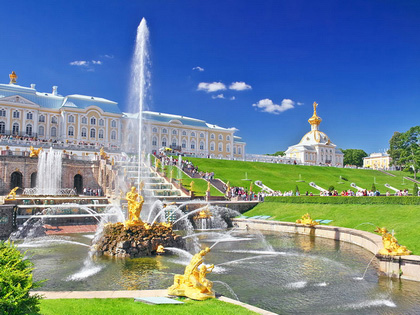
Highlights of St. Petersburg Tour
Explore Russia’s elegant northern capital on this 4-day highlights of St. Petersburg tour. Discover the city’s architecture and history as you visit palaces, canals, and churches, and take an excursion to the magnificent Peterhof Palace and fascinating Kronstadt.
St. Petersburg, Peterhof, Kronstadt
4 Days | All year round | from US$ 427 / personDetails
Peterhof: St Petersburg’s Magical Summer Palace
Peterhof is the most magical palace in Russia. Set in a lush estate on the southern coast of the Finnish Gulf, it was the Royal family’s favourite summer retreat. Generations of Tsars poured fortunes into fashioning Peterhof into a fantasy-land. The original Grand Palace which Peter the Great built was constantly being expanded, till it reached over 300 meters long and included two towering cathedrals on either end of its façade. Considering that the length of Versailles stretches to 400m, one might think that Peter the Great failed to achieve his dream of creating an estate grander than King Louis’s. But it is the gardens and fountains of Peterhof and not its palace that has earned it the title of the world’s most splendid Royal Residence.
Did you know? The Grand Cascade fountain in Peterhof is one of the largest monuments from the XVIII century.
Why Visit Peterhof?
- Fountains: There is no place on earth with fountains as numerous or magnificent as Peterhof. Though the fountains don’t flow with milk and honey, on a hot summer day the spectacular fountains can make the estate seem like paradise.
- Nature: The gardens in Peterhof stretch for miles and include the best landscape design from around the world. Along with the acres of landscaped English parkland, there are stunning French formal gardens surrounding the Grand Palace and pretty Italian terraces tumbling down to the sea.
- Palaces: Peterhof is an estate of not one but many palaces. The variety of architecture reflects the changing tastes over the years. Peter the Great’s humble Mon Plasir looks like a cottage in comparison to the Grand Palace of Elizabeth the Great!
The Fountains of Peterhof
Cascading from the foot of the Grand Palace all the way to the waters of the Baltic sea, the Grand Cascade is one of the 18th century’s most impressive scientific and architectural wonders. Sixty miniature fountains and over 250 golden statues make up the two perfectly symmetrical, tiered fountains which join to form one large marine canal. The gushing of grand waterfalls, splashing of roman fountains, trickle of streams and rippling of ponds filled with swans, saturate the air of this seaside palace with a magical mist that is beyond compare. Though the Grand Cascade is the crowning glory of Peterhof, it is by no means the only fountain. Throughout the grounds, there are 176 fountains in total — far more, Peter the Great would boast, than the 55 in Versailles. Read more about Peterhof’s fountains.
Did you know? All Peterhof’s fountains were designed to run without any pumps. The giant ponds in the Upper Gardens, which were once fish ponds, are high enough to build adequate water pressure to feed even the 21m high, Samson and the Lion spouting fountain!
The Secrets of Peterhof
For all his achievements, the mastermind behind Peterhof was a rascal. Peter the Great delighted in breaking conventions and shocking the Russian nobility. The Summer Palace and Gardens, therefore, were filled with practical jokes ready to be unleashed on tight-lipped aristocrats. By definition, boobytraps are hard to find. Even though visitors to Peterhof now have maps, many aren’t even aware of the secrets within Peterhof — that is unless they are unlucky enough to set a boobytrap off! Here are just a few of the surprises hidden within the grounds:
The Water-Road
Designed in the 1720s by Peter himself, this was the largest of his boobytraps. Perforated pipes were laid down the entire length of one of Peterhof’s tranquil alleyways. At the flick of a hidden switch, Peter could soak up to one hundred people under a downpour! Later tsars, however, seemed to be either far less fun-loving or just not brave enough to soak hundreds of aristocrats at a time because they closed off the pipes as soon as Peter died. Thankfully, the Soviets saw the fun that could be had in wetting tourists and they reopened the Water-Road.
The Grotto
Few tourists ever find out about the Grotto. It’s hidden right under the main attraction — the Grand Cascade — and, apart from being one of the few parts of Peterhof that survived the Nazi occupation intact, it also has a few of Peter’s most ingenious tricks tucked within its cavernous walls. Take the forbidden fruits, though not literally; for if you do succumb to the temptation of reaching out for a plump nectarine from the fruit bowl on the Grotto’s central table, then you shall be punished with an almighty spurt of water! Should you be spooked by the deities with their gaping mouths or the dark corridors, don’t make the mistake of running out in haste. One wrong step and you risk setting off the Curtain of Water!
The Benches
In the quiet of the woodlands lining the Finnish gulf, Peter built himself a homely cottage called Mon Plasir. It’s a charming place, still furnished with Peter’s personal belongings and with a picture-perfect view onto the bay. After walking through hectares of the estate, many a tourist has taken refuge in its walled gardens and rejoiced at seeing a pretty white bench in the shade. Indeed, if you were there in Peter the Great’s day he may well have invited you to join him while sitting on one such bench. Never trust a Romanov! The cobbled stones in front of the benches are a veritable minefield; with every second one positioned above a valve that unleashes torrents of water.
The Green Umbrella
Most umbrellas protect from rain but, in the wonderland that is Peterhof, even the most ordinary things become extraordinary. Built in 1794, a time when Oriental gardens were all the rage, this giant, green umbrella with a bench encircling its base took its stylistic inspiration from Tsarskoye Selo’s Chineese Buildings. Therein ended its connection with China. Serene tea gardens were much too dull for the Tsar so, instead, he rigged the gazebo with a sprinkler system that would trap anyone who sat under it in a circle of water.
Lead Trees and Tulips
When the Nazis seized Peterhof they cut down the estate’s ten thousand trees. The greatest loss though wasn’t the ancient oaks or perfectly clipped lime trees, but rather the 6m high fir trees made entirely of lead tubes. From a distance, their 2,500 painstakingly painted leaves seemed to flutter in the breeze like the surrounding trees but, on closer inspection, visitor’s were shocked to see that the trees and tulips at their base were artificial. Fascinated aristocrats would try to take a closer look at these imitations of nature only to be greeted with hundreds of water spurts from the cracks in trunks of the trees.
Did you know? The Grotto is also home to Peterhof’s original wooden pipework that fed the Grand Cascade and a mini-exhibition on the history of hydraulics.
Visit Peterhof Today
After the barbaric sacking of Peterhof by the Nazis, the communists surprised everyone by full- heartedly committing to restore Peterhof, down to the very last gilded candelabra. Since the 1990s, Peterhof has been a UNESCO-heritage site and it has since been declared one of Russia’s seven wonders.
Peterhof was built to be experienced in summer. Though its palace looks exceptionally large from the outside, inside there are only 30 rooms worth seeing. And, while the hall with 368 paintings is quite a sight, it is the fountains that make Peterhof what it is. To see Peterhof’s fountains, you must come between late April and September. The height of summer is, of course, the best time to visit a summer palace, but May and September are also popular months to visit.
On May 16th the official opening of the fountains is celebrated much as it would have been in Peter’s time with orchestras and dances. The grand closing ceremony in late September, however, is much more modern with light-shows, fireworks and loud music. For St Petersburg, these events are the highlight of the year so it’s best to book tickets well in advance.
If visiting on a normal day, make sure to arrive early and book tickets online to avoid standing in queues for upwards of 20 minutes. After exploring the Upper Gardens, which are rather small and only contain a few fountains, enter the Lower Gardens and follow the crowds to the Grand Cascade which comes to life at 11 each morning. Later, make your way to Peter’s great boobytrap, the Water-Road, which thrills hot and weary travellers with bursts of water at 1 pm, 2 pm and 3 pm sharp.
While marvelling at all the fountains and gawping at the magnificent vistas, keep an eye out for the estate’s cute residents. These tiny red squirrels and chirping blue-tits are so tame that all a passerby needs to do is place a few seeds on an open palm for a whole menagerie of sweet animals to come running and flying to them. Seeds and nuts are sold throughout the park, but the price is as royal as the surroundings so it’s best to buy a pack of sunflower seeds in a shop before the trip.
Did you know? Straight after the Bolshevik revolution, Peterhof was turned into communal flats! Thankfully, the soviets soon saw the blunder they made and soon turned it into a museum.
Attractions
- Текст
- Веб-страница
петродворецПетерго́ф (нидерл. Peter
петродворецПетерго́ф (нидерл. Peterhof, «двор Петра») — дворцово-парковый ансамбль на южном берегу Финского залива в 29 км от Санкт-Петербурга. Находится на территории города Петергоф (с 1944 года по 1997 год [1] — Петродворец). От него происходит название Петергофской дороги. Часть его находится в ведении Государственного музея-заповедника «Петергоф».
Петергоф включает в себя несколько дворцово-парковых ансамблей, формировавшихся на протяжении двух веков. Нижний парк, Верхний сад и Английский парк — ансамбли, получившие развитие в XVIII веке; Александрия, Колонистский парк, Луговой парк, Александровский парк, Сергиевка, Собственная дача Александра II — ансамбли XIX века.
0/5000
Результаты (английский) 1: [копия]
Скопировано!
petrodvorecPetergóf (refer to. Peterhof, Peter «yard») is a Palace and park ensemble on the southern shore of the Gulf of Finland at 29 km from St. Petersburg. Located in the city of Peterhof (1944 year by year 1997 [1], Peterhof). It takes its name from the Peterhof road. Part of it is managed by the State Museum-preserve «Peterhof».Peterhof includes several Palace-park ensemble, had for two centuries. The lower Park, the upper garden and English park-ensembles, translated in the 18th century; Alexandria, Kolonistskij Park, Meadow Park, alexandrovsky Park, Sergievka, a private dacha of Alexander II — ensembles of the 19th century.
переводится, пожалуйста, подождите..
Результаты (английский) 2:[копия]
Скопировано!
petrodvoretsPetergof (niderl Peterhof, «Peter the yard.») — the palace and park ensemble on the southern shore of the Gulf of Finland, 29 km from St. Petersburg. Located in the town of Peterhof (from 1944 to 1997 [1] — Peterhof). From him comes the name of the Peterhof road. Part of it is the responsibility of the State «Peterhof» Museum.
Peterhof includes several palaces and park ensembles, evolved over two centuries. Lower Park, the Upper Garden and the English Garden — ensembles that were developed in the XVIII century; Alexandria Kolonistsky Park Meadow Park, Alexander Park, Sergievka, En cottage Alexander II — ensembles of the XIX century.
переводится, пожалуйста, подождите..
Результаты (английский) 3:[копия]
Скопировано!
петродворецпетерго́ф (нидерл. Peterhof «backyard петра») — дворцово park ensemble on the southern shore of the gulf of finland 29 km away from st. petersburg. is located in the territory of the city of peterhof (from 1944 to 1997 [1] — петродворец). it is the name of петергофской road. part of it is managed by the national museum of the петергоф».peterhof includes several дворцово layouts showing формировавшихся for two centuries. the park, the english garden and park ensembles, as developed in the 18th century, alexandria, колонистский park, meadow park, alexander park, сергиевка, own a alexander ii — from the 19th century.
переводится, пожалуйста, подождите..
Другие языки
- English
- Français
- Deutsch
- 中文(简体)
- 中文(繁体)
- 日本語
- 한국어
- Español
- Português
- Русский
- Italiano
- Nederlands
- Ελληνικά
- العربية
- Polski
- Català
- ภาษาไทย
- Svenska
- Dansk
- Suomi
- Indonesia
- Tiếng Việt
- Melayu
- Norsk
- Čeština
- فارسی
Поддержка инструмент перевода: Клингонский (pIqaD), Определить язык, азербайджанский, албанский, амхарский, английский, арабский, армянский, африкаанс, баскский, белорусский, бенгальский, бирманский, болгарский, боснийский, валлийский, венгерский, вьетнамский, гавайский, галисийский, греческий, грузинский, гуджарати, датский, зулу, иврит, игбо, идиш, индонезийский, ирландский, исландский, испанский, итальянский, йоруба, казахский, каннада, каталанский, киргизский, китайский, китайский традиционный, корейский, корсиканский, креольский (Гаити), курманджи, кхмерский, кхоса, лаосский, латинский, латышский, литовский, люксембургский, македонский, малагасийский, малайский, малаялам, мальтийский, маори, маратхи, монгольский, немецкий, непальский, нидерландский, норвежский, ория, панджаби, персидский, польский, португальский, пушту, руанда, румынский, русский, самоанский, себуанский, сербский, сесото, сингальский, синдхи, словацкий, словенский, сомалийский, суахили, суданский, таджикский, тайский, тамильский, татарский, телугу, турецкий, туркменский, узбекский, уйгурский, украинский, урду, филиппинский, финский, французский, фризский, хауса, хинди, хмонг, хорватский, чева, чешский, шведский, шона, шотландский (гэльский), эсперанто, эстонский, яванский, японский, Язык перевода.
- What is her name?
- nice to live not forbid
- l’amore per i genitori vive in eterno
- В викторианской семье няня занималась с
- Аскаридоз свиней
- There’s no any agreement between Austral
- SHARE OFFERBY KITCHEN MANUFACTURERNext m
- В викторианской семье няня занималась с
- SHARE OFFERBY KITCHEN MANUFACTURERNext m
- The symbolic relationship between the au
- Я не могу сказать точно
- if medicine is taken incorrectly, it may
- brother runing
- if medicine is taken incorrectly, it may
- Processing: Arrived at the place of deli
- Ты меня бесишь
- brother runing
- Tamam iş yoğun
- Immer, wenn Falk und Alexandra eine Klas
- не отвечаю мне
- The symbolic relationship between the au
- Лазить с кем либо
- Чувство юмора
- Иногда по-разному
Слайд 1
Санкт-Петербург ГОУСОШ №127 Красногвардейского р-на Филиппова Татьяна Александровна у читель английского языка
Слайд 2
PETERHOF — THE CAPITAL OF FOUNTAINS
Слайд 3
Peterhof is located 30km west of St. Petersburg on the shores of the Gulf of Finland. It was the summer residence of Peter the Great, built to commemorate victory over the Swedes in 1709 and to show the strength of the Russian Empire . The official opening of Peterhof was on the 15 of August in 1723.
Слайд 4
Peterhof was designed to resemble Versailles in France and architects from all over the world were involved in its design. Over 4000 peasants dug the gardens, parks and canals, and Peter I himself helped to plan the layout of the gardens and fountains. Versailles in France
Слайд 5
Vasily Tuvolkov , Russia’s first hydraulics engineer, built the fountains in 1721-1722.
Слайд 6
The Great Cascade fountain in the gardens has 17 waterfalls, 142 water jets, 66 fountains, 29 bas-reliefs and 39 gilded statues, including the famous five-ton Sampson Fountain. The Grand Cascade divides the Lower Park into east and west.
Слайд 7
Another fountain , the Chessboard Hill, contains some of the best waterfalls cascading over bronze dragons.
Слайд 8
The Triton Fountain shows Neptune’s son wrestling with a sea monster.
Слайд 9
The Pyramid fountain was designed by Peter I and is made up of seven tiers and 505 jets .
Слайд 10
Some of the fountains are there to surprise and amuse visitors. The Little Umbrella fountain sprays out water from 164 jets as soon as anyone sits on a bench underneath it.
Слайд 11
The Little Oak fountain sprays out water if it senses any weight approaching it.
Слайд 12
The Pebbles fountain also drenches visitors who sit on a nearby bench.
Слайд 13
To feel happy and make their spirits high, Russians and foreign visitors come to Peterhof to enjoy its magic charms .
Слайд 14
WELCOME!!!
Слайд 15
Resources: Evans V ., Afanasyeva O., Vaulina J.. Click on Russia Culture Clips 2 / Express Publishing – Centercom , 2003. – p.32 G. Kenyon. The Environs Of Saint Petersburg. Peterhof. Tsarskoye Selo . Pavlovsk. P-2 Art Publishers, St Petersburg, 2002. – p. 63 http :// www.rthvictoria.com/wp-content/ uploads/2015/03/Fontanyi-Petergofa.jpg https://s14.stc.all.kpcdn.net/share/i/4/697709 / wx1080.jpg http:// www.alekseitrofimov.eu/lj2015/201507-saint — petersburg / IMG_40991-SAINT-PETERSBURG-PETERHOF.JPG

Peterhof is a small town, suburb of St. Petersburg. It is located on the shores of the Gulf of Finland, at a distance about 30 kilometers south-west of the center of St. Petersburg. The population of the town is about 78,500 people.
Peterhof got its name from the German word Peterhof — «Peter’s Court». From 1944 to 1997 the town was called «Petrodvorets».
Peterhof was founded in 1710 as the emperor’s country residence. It received the city status in 1762. There were villages Kuusoja and Pohjajoki on the place of Peterhof on the coast of the Gulf of Finland prior to the beginning of the XVIII century. The most famous town landmark is the «Peterhof» museum.
Sea Channel view of the in Peterhof from the Grand Palace is shown in the picture.
The Museum Peterhof includes: «Peterhof Grand Palace,» «Upper Garden», «Lower Park» and other objects.
The most interesting place for tourists (in summer) in Peterhof is «Lower Park». Lower Park has an area about 102 hectares. The park stretches from west to east along the coast of the Gulf of Finland by 2.5 kilometers. Its width from north to south is about 500 meters.
The main decorations of the park are its fountains. «Grand Cascade» fountain is situated in the central part of the park, in front of Grand Palace. «Sea Canal» is laid from the Grand Cascade to the coast. The canal divides the park into two parts. «Adam» and «Eve» fountains, «Chess Mountain» and «Gold Mountain» fountains cascades, Monplaisir Palace and Hermitage Pavilion are located at the equal distance from the canal on both sides of the park. «Oak» and «Umbrella» fountains are children’s favorites. The most famous fountain in the park is «Samson tearing the lion’s mouth» named fountain.
The sculpture «Samson tearing the lion’s mouth» is shown in the photo (water off).
Operating mode of the Peterhof Lower Park
- The park is open (summer 2016): 09:00 — 20:00.
- On Saturdays, the park is open from 9:00 to 21:00.
- Ticket office opening hours: 09:00 — 19:30.
- Fountains operate weekdays from 10:00 to 18:00 on weekends and public holidays from 10:00 to 19:00.
- Launch of the Grand Cascade fountains: 11:00.
- Entrance fee to the Lower Park: 450 rubles (for citizens of Russia and Belarus). There are exemptions for certain categories of citizens. Prices for the summer season 2016. The cost of the full ticket for foreigners is 700 rubles.
How to get to Peterhof
The most convenient way to get to Peterhof is by boat or by bus.
By bus (bus stop «Fountains», «Фонтаны» Петергоф).
From metro station «Avtovo» departs buses № 200, 224, № 300, № 424, № 424-A.
From metro station «Leninsky Prospekt» departs buses number 103, K-224, № 420.
From metro station «Prospect Veteranov» departs buses № 343, № 639-b.
By train from the «Baltic Railway Station», then by bus: № 344, 348, 350, 351, 352,355, 356.
Sea transport departs from the pier on Palace Embankment 18 (near the Winter Palace in St. Petersburg).
By car — check place location on the map. There is a paid parking, but free parking is also available.
1. Peter the Great intended Peterhof to be the ‘Russian Versailles’
During the Great Northern War (1700-1721), Peter the Great defeated the Swedes and secured the region where the Neva River flowed into the Gulf of Finland. In 1703, on this newly-conquered land, he founded St. Petersburg, which became the capital of his empire. Already in 1714, just nearby, on the southern shore of the Gulf of Finland, Peter began to build a country residence — Peterhof, literally “Peter’s court”.
According to the Emperor’s concept, the palace in Peterhof, and most importantly the adjacent park with its fountains, would eclipse the beauty and luxury of Versailles, the residence of the French kings.
2. Unique fountain system
The undoubted jewel and ‘calling card’ of the entire Peterhof complex is the stunning system of fountains, which in 2021 celebrated its 300th anniversary!
Peter wanted the fountains to work without the help of pumps. So, the Russian hydraulic engineer Vasily Tuvolkov invented how to ensure an uninterrupted supply of water. Almost a perpetuum mobile! For this purpose he built a special dam, a system of sluices and ponds, as well as a 24-kilometer canal to bring water to the main fountain, the Grand Cascade.
The Grand Cascade is the most grandiose fountain, which includes two staircases, a grotto and many sculptures. From it, the alley of fountains runs straight into the sea.
In addition, the real masterpieces are the cascades — “Lion” and “Chessboard Hill” — as well as the fountains “Samson” and “Triton”. In total, there are more than 150 different fountains in the palace and park.
There are also trick-fountains in Peterhof, such as «the Benches», in which Peter the Great himself had a hand in designing. When a person comes close to the bench and steps on the stones in front of it, the fountain turns on. Today, it’s a fun attraction for children, but at the beginning of the 18th century Peter greatly enjoyed it when the fountain suddenly doused water on unsuspecting noble lords and ladies.
The Benches trick-fountain
Legion Media
3. Peter the Great’s daughter rebuilt the Great Palace in the baroque style
The Grand Palace — the central and ceremonial part of Peterhof — stretches almost 300 meters parallel to the coastline, towering over the Lower Park and its fountains. Behind the palace is the Upper Garden.
View on the Upper Garden that also has a fountain system
Andrew Shiva (CC BY-SA 4.0)
Initially, the palace looked somewhat modest. Then, in the mid-18th century Empress Elizaveta Petrovna, the daughter of Peter the Great,, rebuilt it in the then fashionable Baroque style according to the design of the talented Italian architect Bartolomeo Rastrelli who also built the Winter Palace and the palace at Tsarskoye Selo. During the 19th century the emperors also slightly altered the palace exterior, adding superstructures and new rooms.
Ivan Aivazovsky. View on the Grand Cascade and the Grand Peterhof Palace. 1837
Public Domain
The palace is rich in decorative elements — sculptures, bas-reliefs and all sorts of twists and turns. The interior decoration is even more pompous and replete with gilding.
The palace was not a permanent residence — the emperors occasionally visited in summer and mostly held entertainment events for the court. During the great feasts of the 19th century, ordinary people were even allowed into the park so that they could admire the greatness of the Empire and the Emperor.
“Imagine a palace built on a natural terrace, which in height can be compared to a mountain in a country of boundless plains, a country so flat that when one ascends a hill sixty feet high the horizon expands almost to infinity. At the foot of this imposing terrace begins a beautiful park, reaching as far as the sea, where navy ships are lined up, illuminated on the evening of the feast,” this is how the Marquis de Custine described the palace he visited in 1839 during an annual extravagant feast arranged by Nicholas I.
Under Catherine the Great an important room in the palace became the new Chesme Hall, built to glorify the decisive victory of the Russian fleet in the Battle of Chesme (1770) during the Russo-Turkish War. The hall is decorated with a series of war paintings devoted to the battle.
4. Peterhof has several palaces
The total area occupied by Peterhof’s palaces, parks and gardens is 414 hectares. Peterhof is not limited to the Grand Palace. To the west, in the 1720s the Marly Palace was built for guests; (referring to the Marly-le-Roi residence of France’s King Louis XIV). It was designed to be reflected in the water, and the pond’s smoothness gives it the appearance of floating in the air.
To the east of the Grand Palace on the shore of the Gulf of Finland is situated a one-story ‘Dutch house’, the Monplaisir Palace. The name translates from French as «my pleasure,» and it was the favorite country palace of Peter the Great.
Next to Monplaisir is located a later building, the one-story Catherine Block, built for the future Catherine the Great, who at that time was only the wife of the crown prince, the future Peter III. After Catherine became Empress (having dethroned her husband), she moved to another, no less luxurious country residence, Tsarskoye Selo.
In addition to these buildings, today the Peterhof museum-reserve also includes nearby palaces and park ensembles (Alexandria, Oranienbaum, Strelna and others), which in the years after Peter the Great the imperial family built for themselves.
The neo-Gothic ‘Cottage’ palace was built for the wife of Nicholas I, Empress Alexandra Feodorovna, and in her honor all of Peterhof with the adjacent park was named Alexandria.
The Grand Menshikov palace was built for Peter’s closest associate in nearby Oranienbaum and it’s the oldest building.
In the middle of the 18th century Emperor Peter III built a «fun» fortress, Peterstadt, and a small palace, also in Oranienbaum.
Not far from here is also Catherine the Great’s private dacha, The Chinese Palace, which is a genuine architectural marvel.
In addition, like the road from Paris to Versailles, the road from St. Petersburg to Peterhof became a grand thoroughfare on which the most important nobles built their dachas.
5. Peterhof was nearly destroyed during World War II
After the 1917 revolution, the Bolsheviks preserved the royal residence and established a museum in Peterhof. In September 1941 it was occupied by the Germans, and until the lifting of the siege of Leningrad in January 1944, Peterhof was under constant bombardment. In fact, the Grand Palace was turned into ruins. Tremendous damage was done to the park and fountains.
A collage shows the Grand Peterhof Palace after the Nazi occupation and after the restoration
Legion Media
Some of the fountain sculptures were hidden or removed in advance, but many of those that remained were destroyed or lost without a trace. The invaders burned a huge number of trees, and while retreating they mined the park. In addition, the Nazis looted many of Peterhof’s treasures, including the grand Neptune Fountain. However, in 1948, the composition was found and returned to its historic location. At the same time, the iconic Samson Fountain was lost and had to be restored anew.
Neptune Fountain
GAlexandrova (CC BY-SA 4.0)
Peterhof began to be restored immediately after the lifting of the Siege, and by the summer of 1945 it was open to visitors. Toward the end of the 1950s the fountains were fully repaired and running again. Nevertheless, the restoration of individual objects of the palace and park ensemble continues to this day.
Dear readers,
Our website and social media accounts are under threat of being restricted or banned, due to the current circumstances. So, to keep up with our latest content, simply do the following:
- Subscribe to our Telegram channel
- Subscribe to our weekly email newsletter
- Enable push notifications on our website
- Install a VPN service on your computer and/or phone to have access to our website, even if it is blocked in your country
If using any of Russia Beyond’s content, partly or in full, always provide an active hyperlink to the original material.
Get the week’s best stories straight to your inbox
|
Напешите на английском языке про город петергоф (много не надо совсем чу чутьPetergof is situated near Saint-Petersburg. At Petergof there are a lot of beautiful places to relax and excursions. Don`t miss the Grand Palace. The Palace was a summer house of Peter the Great and other emperors. This Palace isn`t very ancient but it is very nice and great.There is a very beautiful fountain «Samson» near the Grand Palace. Also you can visit a great park. In this park you can see different trees and flowers. It`s very quiet and nice in the park, that’s why it`s a very good place to relax. Walk around small ponds. Go to comic fountains — it is very funny. Петергоф находится недалеко от Санкт-Петербурга. В Петергофе есть много мест для отдыха и посещения. Не пропустите Большой Дворец. Дворец был летней резиденцией Петра Первого и других императоров. Этот дворец не очень древний, но очень красивый и величественный. Рядом с Дворцом есть великолепный фонтан «Самсон». Также вы можете посетить прекрасный парк. В этом парке вы можете увидеть различные деревья и цветы. В парке очень тихо и красиво, вот почему это очень хорошее место для отдыха. Погуляйте вокруг небольших прудов. Сходите к забавным фонтанам — это очень смешно. Знаете ответ? |
Описание Петергофа на английском языке с переводом
The palace and park ensemble of Peterhof was founded by Peter I in 1705 on the southern shore of the Gulf of Finland in what is now the city of Peterhof.
The Grand Palace is the main building of the palace and park ensemble. The construction of the palace began in 1714 and ended in 1755. The author of the project is Francesco Bartolomeo Rastrelli. The main architectural style is Elizabethan Baroque.
The view of the facade of the Grand Palace from the Upper or Lower Park is impressive, but we must admit that the palace itself is quite narrow and is not as big as it looks. The palace is a three-storey building of almost three hundred meters in length.
Anyone who hears the word “Peterhof” immediately associates it with fountains. These fountains are located in the Lower and Higher Parks of the palace and park ensemble of Peterhof. Experts say that the scale of the fountains of Peterhof exceed the scale of the fountains of the French Versailles. The Lower Park complex has more than 150 fountains and 4 cascades, and in the Upper Garden fountains there are only 5 fountains and one cascade.
The most famous fountains are the “Grand cascade” and “Samson fountain”.
Дворцово-парковый ансамбль Петергоф был основан Петром I в 1705 году на южном берегу Финского залива на территории нынешнего города Петергофа.
Большой дворец является основным зданием дворцово-паркового ансамбля. Строительство дворца началось в 1714 году, а завершилось в 1755 году. Автором проекта является Бартоломео Франческо Растрелли. Основной архитектурный стиль здания – елизаветинское барокко.
Вид на фасад Большого дворца из Верхнего или Нижнего парков впечатляет, но надо признать, что сам по себе дворец довольно узкий и не настолько большой, как выглядит. Дворец являет собой трехэтажное здание протяженностью почти триста метров.
Любой, кто слышит слово «Петергоф», сразу же ассоциирует его с фонтанами. Эти фонтаны располагаются в Нижнем и Верхнем парках дворцово-паркового ансамбля Петергоф. Специалисты утверждают, что масштабы фонтанов Петергофа превосходят масштабы фонтанов французского Версаля. Комплекс Нижнего парка насчитывает более 150 фонтанов и 4 каскада, а в Верхнем саду всего 5 фонтанов и один каскад.
Самые знаменитые фонтаны – это Большой каскад и фонтан «Самсон».
Обновлено: 11.03.2023
Презентация об истории создания одного из самых уникальных культурных наследий России и Санкт-Петербурга — дворцово-паркового ансамбля — Петергофа на английском языке.
| Вложение | Размер |
|---|---|
| The history of Peterhof — a grandiose 18th — 19th century architectural and park ensemble | 2.9 МБ |
Предварительный просмотр:
Подписи к слайдам:
Санкт-Петербург ГОУСОШ №127 Красногвардейского р-на Филиппова Татьяна Александровна у читель английского языка
PETERHOF — THE CAPITAL OF FOUNTAINS
Peterhof is located 30km west of St. Petersburg on the shores of the Gulf of Finland. It was the summer residence of Peter the Great, built to commemorate victory over the Swedes in 1709 and to show the strength of the Russian Empire . The official opening of Peterhof was on the 15 of August in 1723.
Peterhof was designed to resemble Versailles in France and architects from all over the world were involved in its design. Over 4000 peasants dug the gardens, parks and canals, and Peter I himself helped to plan the layout of the gardens and fountains. Versailles in France
Vasily Tuvolkov , Russia’s first hydraulics engineer, built the fountains in 1721-1722.
The Great Cascade fountain in the gardens has 17 waterfalls, 142 water jets, 66 fountains, 29 bas-reliefs and 39 gilded statues, including the famous five-ton Sampson Fountain. The Grand Cascade divides the Lower Park into east and west.
Another fountain , the Chessboard Hill, contains some of the best waterfalls cascading over bronze dragons.
The Triton Fountain shows Neptune’s son wrestling with a sea monster.
The Pyramid fountain was designed by Peter I and is made up of seven tiers and 505 jets .
Some of the fountains are there to surprise and amuse visitors. The Little Umbrella fountain sprays out water from 164 jets as soon as anyone sits on a bench underneath it.
The Little Oak fountain sprays out water if it senses any weight approaching it.
The Pebbles fountain also drenches visitors who sit on a nearby bench.
To feel happy and make their spirits high, Russians and foreign visitors come to Peterhof to enjoy its magic charms .
По теме: методические разработки, презентации и конспекты
Английский язык 10 класс Урок страноведения “Washington is the capital of the USA”
Урок страноведения в 10 классе по английскому языку.
Презентация по теме «Moscow — the capital of Russia»
Компьютерная презентация, подготовленная с участием детей, может использоваться при изучении темы «Москва» как вариант виртуальной экскурсии. тексты к слайдам готовятся отдельно учащимися самостоятель.
Welcome to the capital of Great Britain
Презентация к уроку.
Welcome to the Capital of Great Britain!
Учебная презентация «The capital of Great Britain»
Учебная презентация «The capital of Great Britain».
Washington D.C. is the capital of the USA.
Презентация на английском языке знакомит учащихся 8 класса с историей и достопримечательностями города Вашингтона.
План — конспект урока «London is the capital of Great Britain» 5 класс
представлена разработка конспекта урока по английскому языку для 5 класса.
- Для учеников 1-11 классов и дошкольников
- Бесплатные сертификаты учителям и участникам
- Поможем развить концентрацию и внимание с раннего возраста
- Повысим гибкость и раскованность в общении
Описание презентации по отдельным слайдам:
Made by Nadezhda Knutova Lyceum №4 Form 7A Icons of Russia. Peterhof.
History coat of arms of Peterhof flag of Peterhof 300 years ago, Emperor Peter I founded Peterhof, the summer royal residence. On its territory there are 191 fountains and 4 cascades. All the statues in Peterhof are made of gilded bronze. (1672-1725) Peter I
The most famous icon of Peterhof. The Samson Fountain is the largest and most powerful fountain in the Grand Cascade of Peterhof. It is located in the central part of the basin of the Grand Cascade. Since 1947, «Samson“ has been gilded several times because gilding needs a fresh update because of strong water flows.
My visit to the Peterhof In 2014 I visited Peterhof with my parents and sister. This is a magical place that everyone should visit. I liked it there very much. In future I would like to live in St. Petersburg and visit Peterhof again!
- Поможем развить концентрацию и внимание с раннего возраста
- Повысим гибкость и раскованность в общении
- подготовка к ЕГЭ/ОГЭ и ВПР
- по всем предметам 1-11 классов
Курс повышения квалификации
Дистанционное обучение как современный формат преподавания
Курс профессиональной переподготовки
Английский язык: теория и методика преподавания в образовательной организации
- Сейчас обучается 1146 человек из 83 регионов
Курс повышения квалификации
Специфика преподавания английского языка с учетом требований ФГОС
- ЗП до 91 000 руб.
- Гибкий график
- Удаленная работа
Дистанционные курсы для педагогов
Свидетельство и скидка на обучение каждому участнику
Найдите материал к любому уроку, указав свой предмет (категорию), класс, учебник и тему:
5 601 184 материала в базе
Самые массовые международные дистанционные
Школьные Инфоконкурсы 2022
Свидетельство и скидка на обучение каждому участнику
Другие материалы
Вам будут интересны эти курсы:
Оставьте свой комментарий
- 20.02.2018 1998
- PPTX 4.1 мбайт
- 15 скачиваний
- Оцените материал:
Настоящий материал опубликован пользователем Черных Наталия Ивановна. Инфоурок является информационным посредником и предоставляет пользователям возможность размещать на сайте методические материалы. Всю ответственность за опубликованные материалы, содержащиеся в них сведения, а также за соблюдение авторских прав несут пользователи, загрузившие материал на сайт
Если Вы считаете, что материал нарушает авторские права либо по каким-то другим причинам должен быть удален с сайта, Вы можете оставить жалобу на материал.
Автор материала
40%
- Подготовка к ЕГЭ/ОГЭ и ВПР
- Для учеников 1-11 классов
Московский институт профессиональной
переподготовки и повышения
квалификации педагогов
Дистанционные курсы
для педагогов
663 курса от 690 рублей
Выбрать курс со скидкой
Выдаём документы
установленного образца!
Учителя о ЕГЭ: секреты успешной подготовки
Время чтения: 11 минут
Минпросвещения России подготовит учителей для обучения детей из Донбасса
Время чтения: 1 минута
Курские власти перевели на дистант школьников в районах на границе с Украиной
Время чтения: 1 минута
Школьник из Сочи выиграл международный турнир по шахматам в Сербии
Время чтения: 1 минута
Академическая стипендия для вузов в 2023 году вырастет до 1 825 рублей
Время чтения: 1 минута
В Белгородской области отменяют занятия в школах и детсадах на границе с Украиной
Время чтения: 0 минут
Инфоурок стал резидентом Сколково
Время чтения: 2 минуты
Подарочные сертификаты
Ответственность за разрешение любых спорных моментов, касающихся самих материалов и их содержания, берут на себя пользователи, разместившие материал на сайте. Однако администрация сайта готова оказать всяческую поддержку в решении любых вопросов, связанных с работой и содержанием сайта. Если Вы заметили, что на данном сайте незаконно используются материалы, сообщите об этом администрации сайта через форму обратной связи.
Все материалы, размещенные на сайте, созданы авторами сайта либо размещены пользователями сайта и представлены на сайте исключительно для ознакомления. Авторские права на материалы принадлежат их законным авторам. Частичное или полное копирование материалов сайта без письменного разрешения администрации сайта запрещено! Мнение администрации может не совпадать с точкой зрения авторов.
Санкт-Петербург
Невский пр., д. 108, оф. 16 Н (2 двор).
Обратный звонок
- Экскурсии по рекам и каналам
- Вечерние экскурсии
- Прогулки по Неве
- Пешеходные экскурсии
- Однодневные экскурсии
- Автобусные экскурсии
- Ночные экскурсии
- Ночные экскурсии на автобусе
- Экскурсия на разводные мосты
- Индивидуальные экскурсии
- Обзорные экскурсии
- Экскурсии на английском языке
- Туры выходного дня
- Музеи Петербурга
- Театры Петербурга
- Поездки на Валаам
- Экскурсии в Тихвин
- Экскурсии в Стрельну
- Экскурсии в Старую Ладогу
- Экскурсии в Кронштадт
- Экскурсии в Янтарную комнату
- Экскурсии в Пушкин
- Экскурсии в Псков
- Экскурсии в Петергоф
- Экскурсии в Павловск
- Экскурсии в Гатчину
- Экскурсии в Царское Село
- Экскурсии по рекам и каналам
- Вечерние экскурсии
- Прогулки по Неве
- Пешеходные экскурсии
- Однодневные экскурсии
- Автобусные экскурсии
- Ночные экскурсии
- Ночные экскурсии на автобусе
- Экскурсия на разводные мосты
- Индивидуальные экскурсии
- Обзорные экскурсии
- Экскурсии на английском языке
- Туры выходного дня
- Музеи Петербурга
- Театры Петербурга
- Поездки на Валаам
- Экскурсии в Тихвин
- Экскурсии в Стрельну
- Экскурсии в Старую Ладогу
- Экскурсии в Кронштадт
- Экскурсии в Янтарную комнату
- Экскурсии в Пушкин
- Экскурсии в Псков
- Экскурсии в Петергоф
- Экскурсии в Павловск
- Экскурсии в Гатчину
- Экскурсии в Царское Село
Peterhof (ENGLISH) Петергоф(Англ. яз.)
Peterhof is located on the Southern cost of the Gulf of Finland, 29 kilometers away from St. Petersburg. Here a small house for Peter the Great was built in 1705, where the Tsar could take a rest on his way from Kronstadt to St. Petersburg. In 1714 the Emperor made a decision to turn Peterhof into his main out-of-town residence. Here in the 18th and the 19th centuries a grandiose complex of eleven parks, dozens of buildings, and pavilions with more than 200 fountains and numerous sculptures was formed in the area of over 1000 hectares.
The Grand Palace built to the Elizabeth in baroque style is a composition centre of the Ensemble. The Grand Fountain Cascade, which is unique both technically and artistically, form a decorative pedestal for the Palace. The Grand Cascade embellished with numerous fountains, gilded statutes, bas-relief, and vases is crowned with the sculpture group known as “Samson Tears Open the Lion’s Jaws”, which is dedicated to the victory of Russia in the Northern War.
The Grand Palace from 11 a.m. to 6 p.m., Days off – Monday and last Tuesday of each month.
WELCOME TO OUR EXCURSIONS (5 hrs).
As you travel to Peterhof, you will be given detailed information about the history of the Peterhof Road and the town of Peterhof. Upon arrival, you will embark on a comprehensive tour of the Peterhof Grand Palace and park.
Санкт-Петербург
Невский пр., д. 108, оф. 16 Н (2 двор).
Обратный звонок
- Экскурсии по рекам и каналам
- Вечерние экскурсии
- Прогулки по Неве
- Пешеходные экскурсии
- Однодневные экскурсии
- Автобусные экскурсии
- Ночные экскурсии
- Ночные экскурсии на автобусе
- Экскурсия на разводные мосты
- Индивидуальные экскурсии
- Обзорные экскурсии
- Экскурсии на английском языке
- Туры выходного дня
- Музеи Петербурга
- Театры Петербурга
- Поездки на Валаам
- Экскурсии в Тихвин
- Экскурсии в Стрельну
- Экскурсии в Старую Ладогу
- Экскурсии в Кронштадт
- Экскурсии в Янтарную комнату
- Экскурсии в Пушкин
- Экскурсии в Псков
- Экскурсии в Петергоф
- Экскурсии в Павловск
- Экскурсии в Гатчину
- Экскурсии в Царское Село
- Экскурсии по рекам и каналам
- Вечерние экскурсии
- Прогулки по Неве
- Пешеходные экскурсии
- Однодневные экскурсии
- Автобусные экскурсии
- Ночные экскурсии
- Ночные экскурсии на автобусе
- Экскурсия на разводные мосты
- Индивидуальные экскурсии
- Обзорные экскурсии
- Экскурсии на английском языке
- Туры выходного дня
- Музеи Петербурга
- Театры Петербурга
- Поездки на Валаам
- Экскурсии в Тихвин
- Экскурсии в Стрельну
- Экскурсии в Старую Ладогу
- Экскурсии в Кронштадт
- Экскурсии в Янтарную комнату
- Экскурсии в Пушкин
- Экскурсии в Псков
- Экскурсии в Петергоф
- Экскурсии в Павловск
- Экскурсии в Гатчину
- Экскурсии в Царское Село
Peterhof (ENGLISH) Петергоф(Англ. яз.)
Peterhof is located on the Southern cost of the Gulf of Finland, 29 kilometers away from St. Petersburg. Here a small house for Peter the Great was built in 1705, where the Tsar could take a rest on his way from Kronstadt to St. Petersburg. In 1714 the Emperor made a decision to turn Peterhof into his main out-of-town residence. Here in the 18th and the 19th centuries a grandiose complex of eleven parks, dozens of buildings, and pavilions with more than 200 fountains and numerous sculptures was formed in the area of over 1000 hectares.
The Grand Palace built to the Elizabeth in baroque style is a composition centre of the Ensemble. The Grand Fountain Cascade, which is unique both technically and artistically, form a decorative pedestal for the Palace. The Grand Cascade embellished with numerous fountains, gilded statutes, bas-relief, and vases is crowned with the sculpture group known as “Samson Tears Open the Lion’s Jaws”, which is dedicated to the victory of Russia in the Northern War.
The Grand Palace from 11 a.m. to 6 p.m., Days off – Monday and last Tuesday of each month.
WELCOME TO OUR EXCURSIONS (5 hrs).
As you travel to Peterhof, you will be given detailed information about the history of the Peterhof Road and the town of Peterhof. Upon arrival, you will embark on a comprehensive tour of the Peterhof Grand Palace and park.
Читайте также:
- Сочинение на тему инверсия
- Диван трон обломова сочинение
- Книга в моей жизни сочинение 4 класс литературное чтение
- Василий харитонович белов маляр в моей декоративной мастерской сочинение егэ
- Сочинение на даргинском языке дила гьалмагъ

